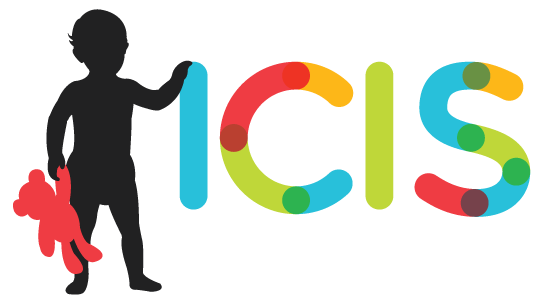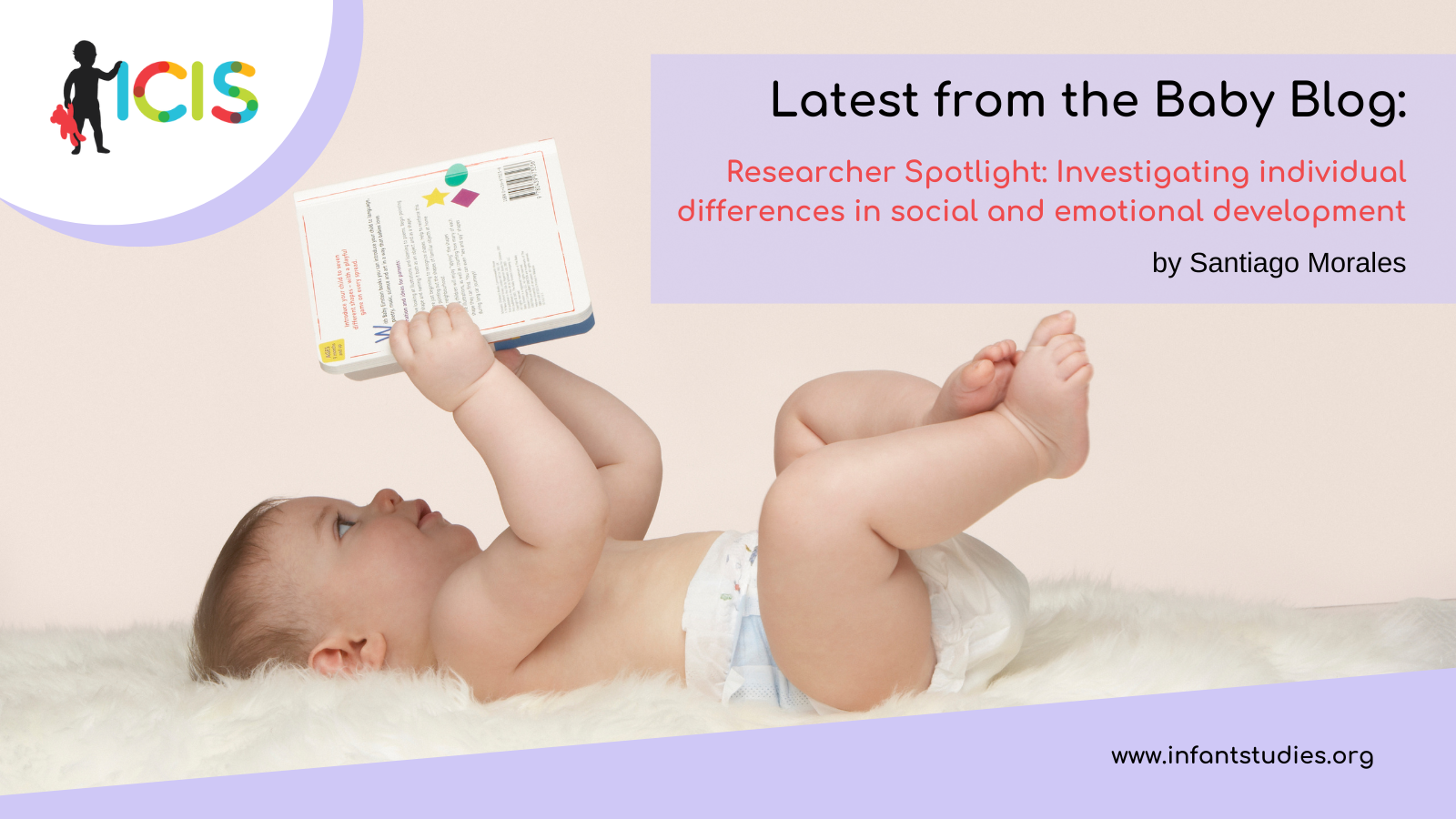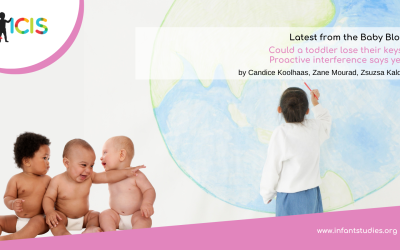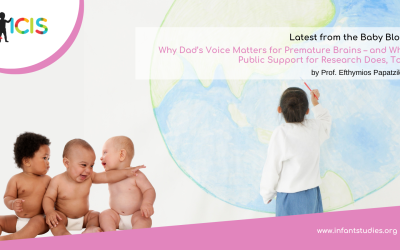Have you ever wondered why people respond so differently to the same stressful situation? My research focuses on understanding this question by studying individual differences in social and emotional development. Specifically, I investigate why and how infants and children vary in the way they express and regulate their emotions—often referred to as temperament. Ultimately, my goal is to uncover how characteristics of children (e.g., temperament) and their environment (e.g., prenatal environmental exposures, parenting, peers, and social context) interact to create the differences we observe in children’s social and emotional lives. By better understanding these differences, we can gain valuable insights into how our personalities develop – and, in some cases, how mental health problems emerge.
Building on decades of research, we now know that some differences in how people respond to stress can be evident as early as infancy. For example, when exposed to new situations, some infants and toddlers respond with hesitation, caution, and even fear, while others readily explore. My interest in these questions began during my undergraduate studies when I investigated how individual squirrels and rats responded differently to new experiences. Preliminarily, we found that individual differences in rats’ fear responses to novelty were relatively stable across contexts and developmental stages, further sparking my interest in temperament. Since then, I have focused my research on human infants and children, demonstrating that infants who are fearful or inhibited in new situations are more likely to grow up to be shy, reserved, and anxious as children, adolescents, and adults1–3. These children are also at increased risk for anxiety and depression1–8. Conversely, infants who are bold, highly active, and excited by novelty tend to be less reserved and more impulsive later in development. At the extreme, this early boldness can lead to challenges such as difficulty following rules and an increased risk of conduct and attention problems1,9–11.
Importantly, while early reactions to novelty can provide clues about emotional and behavioral patterns later in life, not all individuals with either set of high-risk tendencies, even those at the extreme, go on to develop mental health problems. This suggests that other factors, including other individual characteristics of the child as well as external contextual influences, interact with temperament to shape development and outcomes.
In my own research, one child characteristic of particular interest is how children learn to self-regulate their attention, behaviors, and emotions. Self-regulation is a complex and dynamic ability, yet many studies rely solely on questionnaires or behavioral assessments to measure it, which can oversimplify things. To address this, I use various methods, including physiological measurements1, neuroscience tools12–14, micro-coding of behaviors15, computer-based tasks10, and more traditional parent-reported questionnaires11,16. This multi-method approach spanning various aspects of self-regulation provides a nuanced understanding of how self-regulation mediates or moderates the relationship between early temperament and later mental health outcomes. For instance, my recent work differentiates between two components of self-regulation: 1) detecting important stimuli in one’s environment (e.g., threats or novelty) or actions (e.g., errors), and 2) implementing control in response to such stimuli (e.g., increasing attention or inhibiting behavior)17,18. This distinction has helped resolve seemingly contradictory findings in the context of children’s temperament – such that there are mixed findings when self-regulation is considered as a single construct. However, when examined separately as detection and control processes, there is consistent evidence for their involvement (often in opposing directions) in the continuity of fearful temperament and its relation to future anxiety6,19–21.
Another child characteristic that I focus on in my research is how children regulate their emotions. This may sound similar to the previous factor of self-regulation, but this factor is specifically focused on the regulation of one’s emotional responses. For instance, my collaborators and I have examined how children pay attention to others’ emotions, finding that this process acts as an automatic form of emotion regulation that shapes social and emotional development over time10,11,22. In one study, we found that fearful children who also had a heightened attention bias to threats were more socially withdrawn as they transitioned to kindergarten23. In another, we observed that bold, uninhibited children, particularly boys, who also had a heightened attention bias to rewards were more likely to exhibit behavioral problems10. Critically, children who had only one of the candidate predictors did not show these tendencies. We have also demonstrated that these attentional biases can be measured in infancy using tools like eye-tracking technology24–26. Using this approach, we see that even at this early developmental stage, meaningful differences exist that we think may be due to certain contextual factors. For instance, infants of mothers with high anxiety symptoms showed a greater tendency to focus on threatening stimuli27. This highlights the potential for using early markers of attention to predict later social and emotional outcomes. Currently, we are developing new measures of infant attention by measuring their brain activity while they observe others’ emotional expressions, with the goal of improving our understanding of how infants process emotions and their implications for social and emotional development.
In addition to examining individual child characteristics, I also study the role of external contextual factors such as parenting and early life experiences. My collaborators and I are exploring how maternal mental health, maternal physical health, and socioeconomic circumstances affect children’s development28–33. One ongoing project uses caregivers’ smartphones to track their daily emotions, social contexts, experiences, and interactions with their infants. This approach aims to capture the real-world nuances of social and emotional development, identifying risk and protective factors that can inform interventions. Ultimately, this project will contribute to a larger longitudinal study integrating lab-based measures of behavior and brain function with real-world data to better understand the significance of these processes across development.
In summary, my work focuses on understanding how child characteristics, such as temperament and attentional biases, interact with environmental factors, like parenting and social context, to shape children’s socioemotional development. By studying these dynamics, we aim to uncover the roots of individual differences and better understand what makes each of us who we are.
If you are interested in our work, you can visit our website where we describe our current studies as well as how to get involved as a parent or researcher.
- Morales, S., Beekman, C., Blandon, A. Y., Stifter, C. A., & Buss, K. A. (2015). Longitudinal associations between temperament and socioemotional outcomes in young children: The moderating role of RSA and gender. Developmental Psychobiology, 57(1), 105–119. https://doi.org/10.1002/dev.21267
- Tan, E., Zeytinoglu, S., Morales, S., Buzzell, G. A., Almas, A. N., Degnan, K. A., Chronis-Tuscano, A., Henderson, H., Pine, D. S., & Fox, N. A. (2023). Social versus non-social behavioral inhibition: Differential prediction from early childhood of long-term psychosocial outcomes. Developmental Science, e13427.
- Tang, A., Crawford, H., Morales, S., Degnan, K. A., Pine, D. S., & Fox, N. A. (2020). Infant behavioral inhibition predicts personality and social outcomes three decades later. Proceedings of the National Academy of Sciences. https://doi.org/10.1073/pnas.1917376117
- Buss, K. A., Cho, S., Morales, S., McDoniel, M., Webb, A. F., Schwartz, A., Cole, P. M., Dorn, L. D., Gest, S., & Teti, D. M. (2021). Toddler dysregulated fear predicts continued risk for social anxiety symptoms in early adolescence. Development and Psychopathology, 33(1), 252–263.
- Suarez, G. L., Morales, S., Miller, N. V., Penela, E. C., Chronis-Tuscano, A., Henderson, H. A., & Fox, N. A. (2021). Examining a developmental pathway from early behavioral inhibition to emotion regulation and social anxiety: The moderating role of parenting. Developmental Psychology, 57(8), 1261–1273. https://doi.org/10.1037/dev0001225
- Buzzell, G. A., Morales, S., Bowers, M. E., Troller‐Renfree, S. V., Chronis‐Tuscano, A., Pine, D. S., Henderson, H. A., & Fox, N. A. (2021). Inhibitory control and set shifting describe different pathways from behavioral inhibition to socially anxious behavior. Developmental Science, 24(1), e13040. https://doi.org/10.1111/desc.13040
- Morales, S., Taber-Thomas, B. C., & Pérez-Edgar, K. E. (2016). Patterns of attention to threat across tasks in behaviorally inhibited children at risk for anxiety. Developmental Science, 20(2). https://doi.org/10.1111/desc.12391
- Zeytinoglu, S., Morales, S., Lorenzo, N. E., Chronis-Tuscano, A., Degnan, K. A., Almas, A. N., Henderson, H., Pine, D. S., & Fox, N. A. (2021). A Developmental Pathway From Early Behavioral Inhibition to Young Adults’ Anxiety During the COVID-19 Pandemic. Journal of the American Academy of Child & Adolescent Psychiatry, 60(10), 1300–1308. https://doi.org/10.1016/j.jaac.2021.01.021
- Buss, K. A., Kiel, E. J., Morales, S., & Robinson, E. (2014). Toddler Inhibitory Control, Bold Response to Novelty, and Positive Affect Predict Externalizing Symptoms in Kindergarten: Inhibitory Control, Positive Affect, and Externalizing. Social Development, 23(2), 232–249. https://doi.org/10.1111/sode.12058
- Morales, S., Miller, N. V., Troller-Renfree, S. V., White, L. K., Degnan, K. A., Henderson, H. A., & Fox, N. A. (2020). Attention bias to reward predicts behavioral problems and moderates early risk to externalizing and attention problems. Development and Psychopathology, 32(2), 397–409. https://doi.org/10.1017/S0954579419000166
- Morales, S., Pérez-Edgar, K., & Buss, K. (2016). Longitudinal relations among exuberance, externalizing behaviors, and attentional bias to reward: The mediating role of effortful control. Developmental Science, 19(5), 853–862. https://doi.org/10.1111/desc.12320
- Morales, S., Vallorani, A., & Pérez-Edgar, K. (2019). Young children’s behavioral and neural responses to peer feedback relate to internalizing problems. Developmental Cognitive Neuroscience, 36, 100610. https://doi.org/10.1016/j.dcn.2018.12.008
- Morales, S., Bowers, M. E., Leach, S. C., Buzzell, G. A., Fifer, W., Elliott, A. J., & Fox, N. A. (2022). Time–frequency dynamics of error monitoring in childhood: An EEG study. Developmental Psychobiology, 64(3). https://doi.org/10.1002/dev.22215
- Morales, S., Bowers, M. E., Leach, S. C., Buzzell, G. A., McSweeney, M., Yoder, L., Fifer, W., Elliott, A. J., & Fox, N. A. (2023). Development of auditory change-detection and attentional capture, and their relation to inhibitory control. Psychophysiology, 60(4), e14211. https://doi.org/10.1111/psyp.14211
- Morales, S., Ram, N., Buss, K. A., Cole, P. M., Helm, J. L., & Chow, S.-M. (2017). Age-related changes in the dynamics of fear-related regulation in early childhood. Developmental Science, e12633. https://doi.org/10.1111/desc.12633
- Morales, S., Tang, A., Bowers, M. E., Miller, N. V., Buzzell, G. A., Smith, E., Seddio, K., Henderson, H. A., & Fox, N. A. (2021). Infant temperament prospectively predicts general psychopathology in childhood. Development and Psychopathology, 1–10. https://doi.org/10.1017/S0954579420001996
- Morales, S., Zeytinoglu, S., Buzzell, G. A., Valadez, E. A., Troller-Renfree, S. V., Bowers, M. E., Chronis-Tuscano, A., Degnan, K. A., Almas, A. N., Pine, D. S., & Fox, N. A. (2021). Neurocognitive Profiles in Adolescence Predict Subsequent Anxiety Trajectories during the COVID-19 Pandemic. Biological Psychiatry: Cognitive Neuroscience and Neuroimaging. https://doi.org/10.1016/j.bpsc.2021.06.004
- Valadez, E. A., Morales, S., Buzzell, G. A., Troller-Renfree, S. V., Henderson, H. A., Chronis-Tuscano, A., Pine, D. S., & Fox, N. A. (2022). Development of Proactive Control and Anxiety Among Behaviorally Inhibited Adolescents. Journal of the American Academy of Child & Adolescent Psychiatry, S0890856722002118. https://doi.org/10.1016/j.jaac.2022.04.012
- Buzzell, G. A., Troller-Renfree, S. V., Morales, S., & Fox, N. A. (2018). Relations between Behavioral Inhibition, Cognitive Control, and Anxiety: Novel Insights Provided by Parsing Subdomains of Cognitive Control. In K. Pérez-Edgar & N. A. Fox (Eds.), Behavioral Inhibition: Integrating Theory, Research, and Clinical Perspectives (pp. 213–235). Springer International Publishing. https://doi.org/10.1007/978-3-319-98077-5_10
- Fox, N. A., Buzzell, G. A., Morales, S., Valadez, E. A., Wilson, M., & Henderson, H. A. (2021). Understanding the Emergence of Social Anxiety in Children with Behavioral Inhibition. Biological Psychiatry, 89(7), 681–689. https://doi.org/10.1016/j.biopsych.2020.10.004
- Fox, N. A., Zeytinoglu, S., Valadez, E. A., Buzzell, G. A., Morales, S., & Henderson, H. A. (2022). Annual Research Review: Developmental pathways linking early behavioral inhibition to later anxiety. Journal of Child Psychology and Psychiatry, n/a(n/a). https://doi.org/10.1111/jcpp.13702
- Morales, S., Fu, X., & Pérez-Edgar, K. E. (2016). A developmental neuroscience perspective on affect-biased attention. Developmental Cognitive Neuroscience, 21, 26–41. https://doi.org/10.1016/j.dcn.2016.08.001
- Morales, S., Pérez-Edgar, K. E., & Buss, K. A. (2014). Attention Biases Towards and Away from Threat Mark the Relation between Early Dysregulated Fear and the Later Emergence of Social Withdrawal. Journal of Abnormal Child Psychology. https://doi.org/10.1007/s10802-014-9963-9
- Fu, X., Morales, S., LoBue, V., Buss, K. A., & Pérez-Edgar, K. (2020). Temperament moderates developmental changes in vigilance to emotional faces in infants: Evidence from an eye-tracking study. Developmental Psychobiology, 62(3), 339–352.
- Pérez-Edgar, K., Morales, S., LoBue, V., Taber-Thomas, B. C., Allen, E. K., Brown, K. M., & Buss, K. A. (2017). The impact of negative affect on attention patterns to threat across the first 2 years of life. Developmental Psychology, 53(12), 2219.
- Vallorani, A., Fu, X., Morales, S., LoBue, V., Buss, K. A., & Pérez-Edgar, K. (2021). Variable- and person-centered approaches to affect-biased attention in infancy reveal unique relations with infant negative affect and maternal anxiety. Scientific Reports, 11(1), Article 1. https://doi.org/10.1038/s41598-021-81119-5
- Morales, S., Brown, K. M., Taber-Thomas, B. C., LoBue, V., Buss, K. A., & Pérez-Edgar, K. E. (2017). Maternal Anxiety Predicts Attentional Bias Towards Threat in Infancy. Emotion, 17(5), 874–883. https://doi.org/10.1037/emo0000275
- Hernandez, A., Sania, A., Bowers, M. E., Leach, S. C., McSweeney, M., Yoder, L., Fifer, W., Elliott, A. J., Shuffrey, L., Rauh, V., Him, D. A., Fox, N. A., & Morales, S. (2024). Examining the impact of prenatal maternal internalizing symptoms and socioeconomic status on children’s frontal alpha asymmetry and psychopathology. Developmental Psychobiology, 66(3), e22476. https://doi.org/10.1002/dev.22476
- Morales, S., Bowers, M. E., Shuffrey, L., Ziegler, K., Troller-Renfree, S., Hernandez, A., Leach, S. C., McGrath, M., Ola, C., Leve, L. D., Nozadi, S. S., Swingler, M. M., Lai, J.-S., Schweitzer, J. B., Fifer, W., Camargo Jr., C. A., Khurana Hershey, G. K., Shapiro, A. L. B., Keating, D. P., … Elliott, A. J. (2024). Maternal education prospectively predicts child neurocognitive function: An environmental influences on child health outcomes study. Developmental Psychology, No Pagination Specified-No Pagination Specified. https://doi.org/10.1037/dev0001642
- Rayport, Y. K., Morales, S., Shuffrey, L. C., Hockett, C. W., Ziegler, K., Rao, S., Fifer, W. P., Elliott, A. J., & Sania, A. (2024). Prenatal risk factors for child executive function at 3–5 years of age: The roles of maternal mood, substance use, and socioeconomic adversity in a prospective cohort study. BMC Pediatrics, 24(1), 682. https://doi.org/10.1186/s12887-024-05113-2
- Shuffrey, L. C., Lucchini, M., Morales, S., Sania, A., Hockett, C., Barrett, E., Carroll, K. N., Cioffi, C. C., Dabelea, D., Deoni, S., Dunlop, A. L., Deutsch, A., Fifer, W. P., Firestein, M. R., Hedderson, M. M., Jacobson, M., Kelly, R. S., Kerver, J. M., Mason, W. A., … Monk, C. (2022). Gestational diabetes mellitus, prenatal maternal depression, and risk for postpartum depression: An Environmental influences on Child Health Outcomes (ECHO) Study. BMC Pregnancy and Childbirth, 22(1). https://doi.org/10.1186/s12884-022-05049-4
- Shuffrey, L. C., Morales, S., Jacobson, M. H., Bosquet Enlow, M., Ghassabian, A., Margolis, A. E., Lucchini, M., Carroll, K. N., Crum, R. M., Dabelea, D., Deutsch, A., Fifer, W. P., Goldson, B., Hockett, C. W., Mason, W. A., Jacobson, L. T., O’Connor, T. G., Pini, N., Rayport, Y., … program collaborators for Environmental influences on Child Health Outcomes. (2023). Association of Gestational Diabetes Mellitus and Perinatal Maternal Depression with Early Childhood Behavioral Problems: An Environmental Influences on Child Health Outcomes ( ECHO ) Study. Child Development, 94(6), 1595–1609. https://doi.org/10.1111/cdev.13938
- Xu, X., Buzzell, G. A., Bowers, M. E., Shuffrey, L. C., Leach, S. C., McSweeney, M., Yoder, L., Fifer, W. P., Myers, M. M., Elliott, A. J., Fox, N. A., & Morales, S. (2024). Electrophysiological correlates of inhibitory control in children: Relations with prenatal maternal risk factors and child psychopathology. Development and Psychopathology, 1–14. https://doi.org/10.1017/S0954579424000816
About the Author

Santiago Morales
Assistant Professor of Psychology and PediatricsUniversity of Southern California
Santiago Morales is an assistant professor of psychology and pediatrics at the University of Southern California. Dr. Morales completed his Ph.D. and M.S. in Developmental Psychology at The Pennsylvania State University and a postdoc at the University of Maryland. His research has been recognized by national and international academic societies, awarding him four early career contribution awards, including from APS, APA, SRCD, and the International Society of Developmental Psychobiology.
Personal Website: https://www.santiagomorales.net/
Twitter Handle: @SantiMoralesPhD




